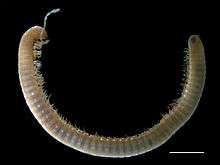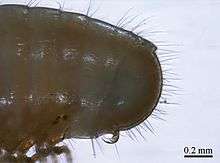Titanophyllum
Titanophyllum spiliarum is a species of cave-dwelling millipede in the family Julidae. The only known species of the genus Titanophyllum, it was described in 2011 from specimens discovered in a cave in Greece. It has several unusual characteristics including eyelessness and a small hook on its hind-most body section that may be involved in keeping the animal ‘locked’ when it coils-up defensively.
| Titanophyllum | |
|---|---|
 | |
| Scientific classification | |
| Kingdom: | |
| Phylum: | |
| Subphylum: | |
| Class: | |
| Order: | |
| Family: | |
| Genus: | Titanophyllum Akkari, Stoev, & Enghoff, 2011 |
| Type species | |
| Titanophyllum spiliarum Akkari, Stoev, & Enghoff, 2011 | |
Description

T. spiliarum specimens measure 17 – 33 mm in length and 1 to 1.4 mm wide. The pale yellow body consists of a head followed by 47-61 body segments with legs, 1-2 legless segments, ending in a telson (legless, last body segment). The walking legs are about 80% the body width. Eyes are absent. Like other members of the Julida, mature males have two pairs of highly modified legs, the gonopods, in place of the 8th and 9th pair of walking legs. Unusual among Julid millipedes, the telson possesses a small, forward-projecting hook on the hypoproct or subanal scale (the small plate below the anus). The function of the so-called “subanal hook” is unknown, but as it appears in both sexes and in juveniles, is thought to be related to survival rather than reproduction or attracting mates. Subanal hooks are known in only of few members of the Julidae, including species of Unciger, Syrioiulus, and Typhloiulus, and may aid in keeping the body in a defensive coil or spiral when threatened.[1]
Discovery
T. spiliarum was described from several specimens originally collected from a cave in Magnesia, Greece in 2003. It was described as a new genus and species in 2011 by a team of Danish and Bulgarian scientists.[1]
Etymology
The genus name Titanophyllum derives from to the name of the cave where the species was discovered (Titanospilia, “the cave of Titans”), and the suffix -phyllum, a reference to the leaf-shaped posterior gonopods. The species name means “of the caves” in Greek.[1]
See also
- Mammamia, another European cave-dwelling millipede described along with Titanophyllum
- Trichopetalum whitei, a North American cave-dwelling millipede
References
- Akkari, N.; Stoev, P.; Enghoff, H. (2011). "Two new cavernicolous genera of Julidae (Diplopoda , Julida), with notes on the tribe Brachyiulini and on julid subanal hooks and anchors". ZooKeys. 114: 1–14. doi:10.3897/zookeys.114.1490. PMC 3130342. PMID 21976993.